What Are Some Animal Populations That Will Be Harmed By Climate In Change
Earth has a history of climatic change
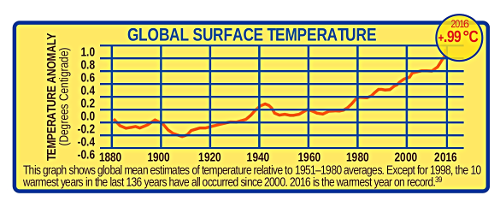 Changes in the sun, the Earth's orbit, ocean currents and volcanic eruptions are natural effects on climate. Studies of tree rings, glacial layers, body of water sediment, pollen remains, sedimentary rocks, coral reefs and air trapped in bubbles in water ice cores, reveal a climate record going dorsum hundreds of thousands of years. Fossil records testify that in the by 490 million years dramatic changes in climate have caused at least five mass extinctions. Some studies judge that the current charge per unit of extinction is 100 times faster than what would occur without human bear upon.
Changes in the sun, the Earth's orbit, ocean currents and volcanic eruptions are natural effects on climate. Studies of tree rings, glacial layers, body of water sediment, pollen remains, sedimentary rocks, coral reefs and air trapped in bubbles in water ice cores, reveal a climate record going dorsum hundreds of thousands of years. Fossil records testify that in the by 490 million years dramatic changes in climate have caused at least five mass extinctions. Some studies judge that the current charge per unit of extinction is 100 times faster than what would occur without human bear upon.
The climate is irresolute at present
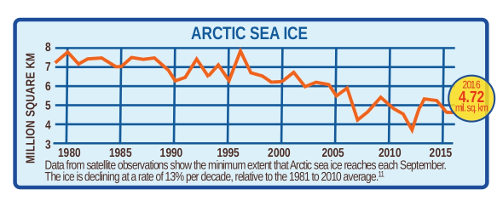 Indicators that the climate is changing include: rising hateful temperatures; rise body of water temperatures; increased sea acerbity; bounding main level rise; decrease of ice in the Arctic and Antarctic; and retreat of most all alpine glaciers. Recent studies show that the paths and speed of the northern jet stream (large rivers of wind loftier in the temper) are shifting because of warmer temperatures in the Arctic—bringing colder winters
Indicators that the climate is changing include: rising hateful temperatures; rise body of water temperatures; increased sea acerbity; bounding main level rise; decrease of ice in the Arctic and Antarctic; and retreat of most all alpine glaciers. Recent studies show that the paths and speed of the northern jet stream (large rivers of wind loftier in the temper) are shifting because of warmer temperatures in the Arctic—bringing colder winters
Today's climate alter is from human causes
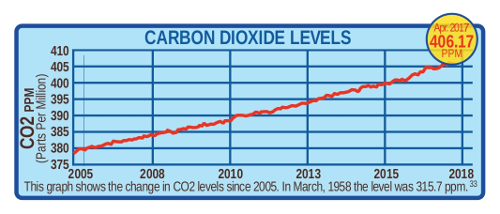 The ascendant crusade of present-day climate change is the increase in carbon dioxide, methane and other greenhouse gases emitted into the atmosphere past man activities.* Higher concentrations of greenhouse gases are the predominant cause of warming temperatures—geological history shows that every bit levels of greenhouse gases increased, the earth warmed. Climate change will likely exist one of the chief drivers of extinction in the 21st century because of the speed at which boilerplate temperatures are warming—faster than at any time in the terminal xv,000 years.
The ascendant crusade of present-day climate change is the increase in carbon dioxide, methane and other greenhouse gases emitted into the atmosphere past man activities.* Higher concentrations of greenhouse gases are the predominant cause of warming temperatures—geological history shows that every bit levels of greenhouse gases increased, the earth warmed. Climate change will likely exist one of the chief drivers of extinction in the 21st century because of the speed at which boilerplate temperatures are warming—faster than at any time in the terminal xv,000 years.
* 97% of active climate scientists agree that today's climatic change is caused past man activities
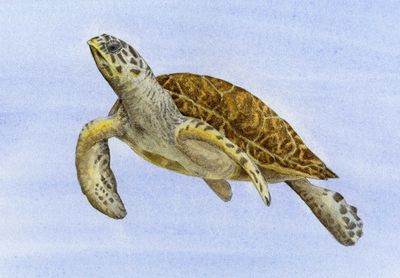
Species are at adventure of extinction
A global mean temperature rising of 2 to 3 °C will profoundly increase the percentage of species at risk and amplify the dangerous impacts on biodiversity and ecosystems. If an ecosystem is already degraded from other causes non related to climate, such equally pollution, a species is less resilient or likely to conform. The animals shown here illustrate the wondrous diversity of life on Earth, and also highlight the many means climate change puts all forms of life on the planet, including humans, at risk.
Educational Affiche and Presentation
"Wonderful project. ...the earlier we convey this information to students the amend information technology is for the planet." Alexander More than Historian and Climate Scientist, Harvard
"Very prissy graphics and important messages." Dr. Paul Andrew Mayewski Director, Climate Change Found Univ. of Maine
"Brilliant! As a showtime, every high school science classroom should have a copy of this affiche." Dr. Tara Martin IUCN Species Survival Commission'south Climate Modify Specialist Grouping
"An easy, responsible, engaging resources for explanation of a very complicated procedure and very critical condition." Peter Neill World Ocean Observatory
"…brings essential chat on climate change to the forefront through the use of this animal information to make the problem real." Jaclyn Stallard Project Learning Tree
"This affiche is incredible!" Education Team Polar Bears International
"I am astounded at how awesome the poster is!" Wendy Foden Chair: IUCN Species Survival Commission's Climate Change Specialist Group
"…a useful resource for pedagogy virtually climatic change in biology, ecology science, and earth science classes…" Becky Remis National World Scientific discipline Teachers Association
"The presentation is extremely valuable for my work and pedagogy....You present some of the findings better than I take in the original study." Wendy Foden Chair, IUCN Climate change Specialist Group: Species Susceptibility to Climatic change Impacts
"...a key piece of data in the first deep-dive unit I've ever done on climate change." Diana Allen President, Maine Science Teachers Association
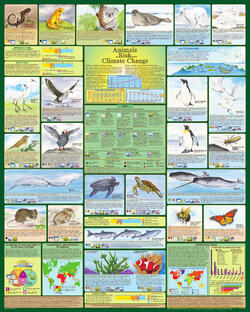
coil over to zoom.
The Animals at Hazard from Climate change educational poster presents a succinct overview of the key impacts of greenhouse gases—the causes, effects and risks to all forms of life on the planet.
By highlighting 25 animals selected for their vulnerability to climate change, the complex interaction of biological traits and environmental weather that cause a species to be susceptible are made simple and understandable through illustrations, key graphics and cursory explanatory text.
24" x xxx", printed on FSC certified recycled newspaper.
The Presentation
The 75 folio downloadable presentation includes all illustrations, keys, text and charts from "Animals at Gamble from Climate change"—a unique and timely companion to the wall poster. The flexible PDF platform functions both equally a carefully sequenced slide testify and a set of printable handouts.
" The presentation is extremely valuable for my work and teaching....Yous present some of the findings ameliorate than I take in the original written report."
~Wendy Foden, Chair, IUCN Climate Change Specialist Group: Species Susceptibility to Climate Change Impacts
Without the constraints of the printed format, we take added a 15 page appendix detailing the complexities of topics that include: the sixth mass extinction; scientific consensus; education and climate change; volcanoes; water vapour; abrupt climate change; mitigation; and geoengineering.
A useful tool for classroom or public demonstrations; the synergy that comes from many people coming together and reaching a collective awareness has power and can exist the start of awareness and change.
Please note: the purchase of the presentation is intended for a single user. Nosotros are a small non-profit arrangement, so if y'all would like to share or distribute additional copies, we enquire that you buy them, brand a donation, or contact the states and let us know. Many thanks.
Comprehensive and rigorously annotated to reliable sources, these resources are valuable, timely and relevant educational aids. If y'all are an educator, activist, retailer, or interested in becoming a sponsor to enable free distribution to teachers, please contact u.s. at mm@theglobaleducationproject.org or 250 895 4327.
Gild now for your classroom or programs >>>
The Animals At Adventure
 Koala
Koala
Koalas alive in the woodlands of Australia. Thick fur and skin make it difficult for them to adapt to rise temperatures. Increased CO2 in the air produces less poly peptide in the eucalyptus leaves, forcing the Koala to search for other sources of food and, in times of high heat, water. On the ground, the slow moving Koalas are prey to wild dingoes and domestic dogs, or are hitting by cars equally they cross roads. Their habitats are also being destroyed by drought, bush fires and evolution.
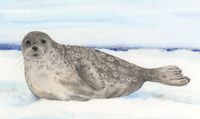 Ringed Seal
Ringed Seal
All populations of Ringed Seals are expected to be adversely affected by climate change because of dependence on sea ice and snow dens for convenance, protecting pups, moulting and resting. Early warming causes pups to dissever prematurely from their mothers. As sea water ice declines, other threats are fisheries by-take hold of, increased shipping, tourism and development. Seals are vulnerable to disease from heavy concentrations of pollutants that have accumulated in the Chill food web.
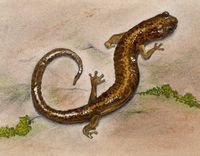 Shenandoah Salamander
Shenandoah Salamander
The Shenandoah Salamander lives in an isolated, high distance region of Shenandoah National Park, Us. Similar all amphibians who have sparse, permeable skin, salamanders are very sensitive to environmental changes. If boilerplate temperatures or wet increment, this salamander, restricted to its cool micro-climate, will exist at risk—having no place to get merely to lower, even warmer, altitudes. If warming causes other species of lower altitude salamanders to migrate college, they will compete for the Shenandoah's absurd, moist habitats.
 Polar Bear
Polar Bear
Polar Bears live only in the Arctic. Loss of body of water water ice has a critically adverse event on Polar Bears. They hunt from the border and build snowfall dens on the ice for resting and raising their cubs. Ocean ice reject could open the Arctic to shipping and tourism, further disturbing Arctic habitats. Other threats are oil development and industrial pollution that reaches the Arctic through air and sea currents.
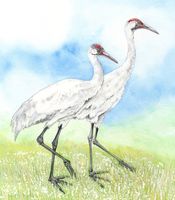 Whooping Crane
Whooping Crane
Before 1800 in that location were an estimated 10–20,000 Whooping Cranes in Due north America. By 1941, because of hunting and habitat destruction, there were fewer than 20. There are at present approximately 350–380 in the wild. The wild Whooping Crane population has merely i winter habitat—a wildlife refuge on the Gulf Coast in Texas; and one spring breeding habitat—a prairie wetlands in Alberta. Severe storms, sea level rising, drought, industrial development and oil spills threaten these habitats. Another significant threat to young Whooping Cranes is colliding with ability lines in their migration corridor.
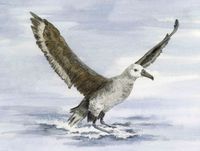 Blackness-footed Albatros
Blackness-footed Albatros
Almost all Black Footed Albatrosses live in the Hawaiian Islands. Like all species of albatrosses that breed on low lying beaches and slopes, they are highly susceptible to sudden flooding from sea level rise and storm surges. Thousands each year are caught by longline fishing and they are as well threatened by pollution and ingesting plastics that bladder in the ocean.
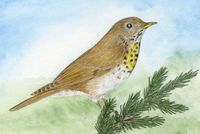 Bicknells Thrush
Bicknells Thrush
The breeding habitat of Bicknell's Thrush is primarily restricted to mountain spruce forests of Northeastern US and Canada. They wintertime in the Caribbean and bound migration north is cued by mean solar day length. If bound arrives early on in the north and the Thrushes arrive at their normal fourth dimension, the affluence of food—insects and fruit—would already have peaked. Warming temperatures as well produce an abundance of spruce and fir cones—feeding and increasing the population of Red Squirrels, a main predator of eggs and chicks. Storms and hurricanes threaten the Thrush's tropical winter habitat. Pollution, logging and deforestation threaten their spring breeding and wintertime habitats.
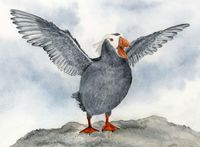 Tufted Puffin
Tufted Puffin
Tufted Puffins are threatened by sea level rise and storm surges which destroy habitats and convenance areas. In some areas of North America warming seas are causing the fish that the Puffins feed on to migrate farther north, making it difficult for them to find adequate food. Other threats are entrapment in line-fishing nets, oil spills, pollution, ingestion of plastic, human being disturbance of breeding colonies and introduced predators such equally rats and foxes.
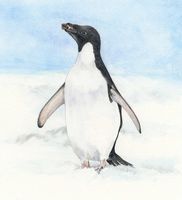 Adelie Penguin
Adelie Penguin
In winter, the sun doesn't rise south of the Antarctic Circle. If Antarctic sea ice decreases and does not extend far plenty to the north, Adélie Penguins, during their winter migration, may not be able to attain the sunlight needed to navigate, chase and avoid predators—they won't swoop in the nighttime. Other threats are oil pollution, fishing and disturbance of colonies from research stations and aircraft.
 Beluga
Beluga
Belugas live in Arctic and Sub-Arctic waters. Impacts from climate change include: an increment in ship traffic as sea water ice declines, oil exploration and extraction, fisheries by-catch, and disruption of the food web. Every bit Chill waters warm and currents change, the Humpback (a competitor) and the Orca (a predator) may move north and stay longer. Some Beluga populations are besides threatened by hunting, pollution and habitat loss.
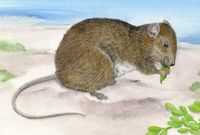 Bramble Cay Melomys
Bramble Cay Melomys
The Bramble Cay Melomys was the first species to be alleged extinct considering of climate change. Sea level ascent and storm surges done away its habitat, food and the last of the population. In 2014 scientists went searching in the hopes of starting a breeding program but were unable to find a pair. Other body of water birds and turtles that live on the Cay are also threatened by storm surges and bounding main level rise.
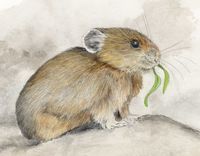 American Pika
American Pika
American pikas occupy talus—rock piles that accumulate at the base of a gradient—at high elevations in western mountains. Pikas are thought to exist a prime number instance of the potential effects of climatic change because they are sensitive to warm temperatures and rely on insulation provided by snow to survive cold winter temperatures. However, several contempo studies point that pikas tin be resilient to each of these factors. Most pikas in the Sierra Nevada survived the winter of 2014, when there was virtually no snowpack. Pikas persist in many hot localities as well, demonstrating their ability to cope with high temperatures.
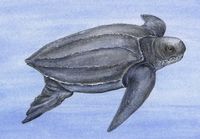 Leatherback Sea Turtle
Leatherback Sea Turtle
Climate change impacts the Leatherback in ii main ways: an increase in the temperature of nesting sands causes a greater proportion of females to hatch, destabilizing future populations; and bounding main level rise and stronger, more frequent storms erode nesting beaches and wash away eggs and hatchlings. The Leatherback is also threatened from fisheries past-take hold of, egg drove, coastal development, pollution and ingestion of floating plastics.
 Hawksbill Sea Turtle
Hawksbill Sea Turtle
Climate alter may touch Hawksbill Turtles in various ways because they live in different habitats at different stages of life: open sea, beaches, lagoons and coral reefs. Ascent sand temperature of nesting beaches produces more females and other abnormalities in baby turtles. Adults alive primarily in coral reefs—threatened by rising bounding main temperature and acerbity. Since aboriginal times the Hawksbill has been exploited for its shell. They are also threatened from fisheries by-catch, development, and a high sensitivity to oil spills. The population has decreased by an estimated fourscore% in the final 100 years.
 Narwhal
Narwhal
The Narwhal lives mainly in the Atlantic Arctic. Considering of specialized habitat, narrow range and limited diet (Arctic cod and halibut), information technology is i of the Arctic species most vulnerable to climate change. The Narwhal breeds in bays and fjords, moving offshore during winter to areas of heavy ice pack, breathing through the few cracks. Sudden or extreme temperature change can cause these cracks to freeze shut, trapping the whales. Other threats are illegal hunting, industrial activities, and risks from oil development, exploration and shipping in the Arctic.
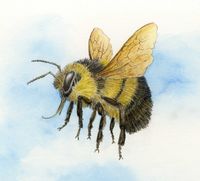 Rusty Patched Bumble Bee
Rusty Patched Bumble Bee
The Rusty Patched is the first bee to be listed every bit endangered in the Us. Populations take declined as much as 87% from habitat loss, illness and pesticides. Climate threats include: warming and precipitation, early snowfall, late frost and drought. Bees and butterflies are of import agricultural pollinators. In 2016, twoscore% of invertebrate pollinators (bees and butterflies) were listed as threatened with extinction.
 Monarch Butterfly
Monarch Butterfly
The almanac Due north American migration of the Monarch is listed as a "threatened phenomenon." Climate related threats include: drought, storms, changes in precipitation and dependence on temperature to trigger migration and reproduction. The Monarch feeds and lays eggs exclusively on milkweed plants, and so information technology is also highly vulnerable to herbicides and habitat destruction.
 Sockeye Salmon
Sockeye Salmon
For decades wild salmon populations take been in decline from homo causes: over fishing; habitat deposition—logging, mining, agriculture and dams; pollution; and interaction with hatchery or farmed salmon. These weather and threats may hinder their ability to conform to the furnishings of climate change. Salmon thrive at specific freshwater temperatures—warming air raises water temperature. Early snow melt and increased rains cause physical changes to spawning streams.
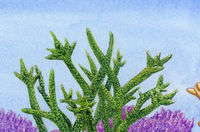 Staghorn Coral
Staghorn Coral
In the last 30 years the Staghorn Coral population has decreased past 80% from disease, pollution, development and harm. Climate modify is increasing the gamble of extinction. Corals live in symbiotic (mutually benign) relation with algae. The coral receives nutrients and oxygen from algae, and the algae receive nutrients and carbon dioxide from the coral. Ascent body of water temperature increases algae growth so oxygen levels become likewise high for the coral, causing "bleaching"—the coral expels the algae and dies. Higher body of water acerbity contributes to bleaching and also reduces the ability of corals and other marine animals to build hard shells. Other threats from climate modify are sea level ascension, changes in currents and tempest damage.
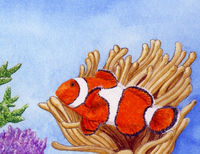 Common Clownfish
Common Clownfish
Clownfish alive in the shallow waters of coral reefs where they have a mutually beneficial relation with a few species of sea anemone. The anenome protects the Clownfish, and the fish's pond aerates the water effectually the anenome. Clownfish are unable to move long distances, and rising ocean temperature and acidity is a threat to their coral reef habitats. Increased acidity as well seems to impair their ability to navigate to their home anemones.
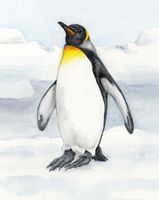 Emperor Penguin
Emperor Penguin
In 50 years, the hateful temperature of western Antarctica has risen most 3 °C—more than any other region—reducing the extent and thickness of winter ice. The Emperor Penguin is dependent on the ice for convenance, raising chicks and moulting. Less sea ice decreases zooplankton (krill) which feed on algae that abound on the underside of the ice. Krill are an important part of the food spider web for the Emperor and other Antarctic marine species.
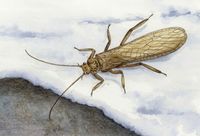 Western Glacier Stonefly
Western Glacier Stonefly
Since 1960, the average summer temperature in Glacier National Park has increased past effectually 1 °C and glaciers take declined past 35%. Past counting Stoneflies, scientists can decide how chop-chop glaciers are melting and the temperature of streams. In a ii yr search begun in 2011, scientists constitute the Stonefly in only ane of the half dozen streams it had previously occupied and discovered that information technology had retreated to two unlike streams at college altitudes. Satellite data confirm that the world'south glaciers are failing, affecting the availability of fresh water for humans, animals and plants, and contributing to body of water level ascent.
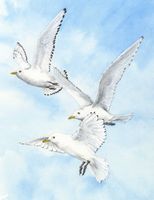 Ivory Gull
Ivory Gull
Ivory Gulls are well-nigh entirely dependent on sea ice and glaciers for nesting and nutrient foraging. They feed on fish and shellfish that thrive near the edge of the ice, and on the remains of seals left by Polar Bears. Seal blubber is a source of heavy contaminants—Ivory Dupe eggs prove a higher concentration of mercury and pesticides than any Arctic ocean bird. Other threats are illegal hunting and disturbance from diamond mining in the Canadian Arctic.
 Arctic Fox
Arctic Fox
The Arctic tundra is a region of shrubs, grasses and permanently frozen subsoil. Warming could change the tundra to boreal forest—habitat for the Ruddy Play a joke on. The Ruby-red Fox, a predator and a competitor for nutrient, is already beginning to migrate north into the Arctic Fox'south territory. Milder tundra weather also causes changes in the population of lemmings and rodents—main food for the Chill Flim-flam.




Source: https://www.theglobaleducationproject.org/climate-change/
Posted by: dennisalannow.blogspot.com

0 Response to "What Are Some Animal Populations That Will Be Harmed By Climate In Change"
Post a Comment